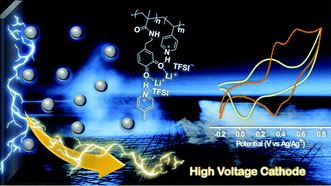Development of Polymeric Nanoparticles as an Electrode Material in Lithium Batteries
There is a growing interest in the development of organic materials with redox activity to be used in batteries. The main objective is to replace the inorganic materials currently present in the electrodes since, in many cases, they contain toxic elements, scarce and very unsustainable, such as cobalt. Organic materials, on the other hand, are composed of very abundant elements (CHON) and are much more sustainable and easy to recycle. At IMDEA Energía we are working on the synthesis of organic polymers with redox properties that can compete in performance with current materials. In one of our latest works*, in collaboration with the University of the Basque Country and the University of Liège (Belgium), we have developed a new polymer that combines catechol and pyridine redox units. This combination of functional groups causes the redox potential of the material to shift towards positive potentials, giving rise to higher voltage batteries. In addition, the morphology of the material, in the form of nanoparticles of different sizes, is investigated, showing that nanostructuring in the form of nanoparticles provides a faster response to batteries.
(*) Proton trap effect on catechol-pyridine redox polymer nanoparticles as organic electrodes for lithium batteries Gallastegui, A., Minudri, D., Casado, N., Goujon, N., Ruipérez, F., Patil, N., Detrembleur, C., Marcilla, R., Mecerreyes, D. (2020) Sustainable Energy and Fuels, 4 (8), pp. 3934-3942. DOI: 10.1039/d0se00531b
More information: Rebeca Marcilla, Senior Researcher, Electrochemical Processes Unit, This email address is being protected from spambots. You need JavaScript enabled to view it.
Tags: Rebeca Marcilla, European Project, Organic polymers, Nanoparticles, Lithium Batteries



